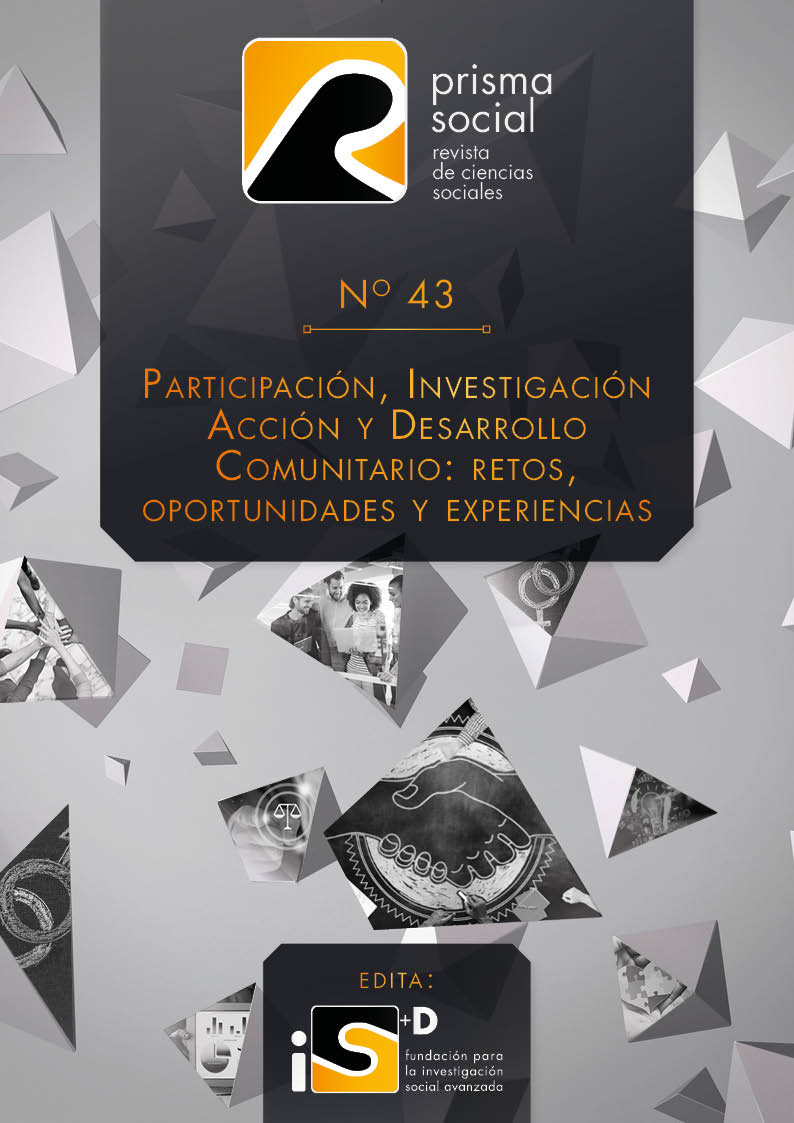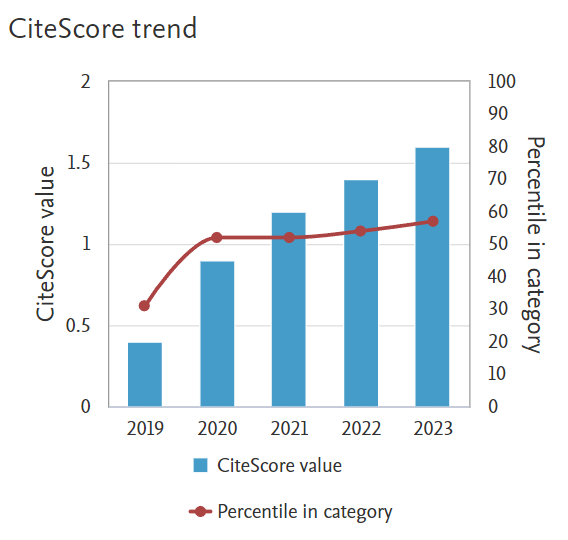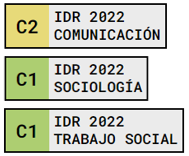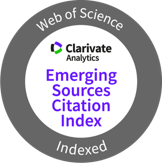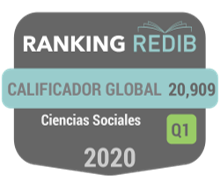Rrom participation in Castilla-La Mancha (Spain)
Convergences and divergences between the social actors
Keywords:
Participation, Rrom, Social Work, Social Services, Third Sector, Social InnovationAbstract
What is the perception of social services professionals regarding the participation of the Roma people in Castilla-La Mancha? What is the self-perception of the Roma people regarding their participation? This work examines the main participation trends in Rrom populations who are living in Castilla-La Mancha Region and the perception of social workers and third sector professionals as well.
The methodology is qualitative and quantitative based. The qualitative method aims to answer about research subject who represented the Rrom people in Castilla-La Mancha (n=98), they participated in ten focus group that were developed in nine cities. The quantitative method aims to obtain professional details about their Rrom’s perceptions, the online questionary was applied (n=50).
The results offer a descriptive and inferential analysis about participation variables and difficult perception in Rrom participation. The conclusion emphasizes on relevant needs in Rrom people, and it creates a differentiation between collectives and Rrom community in Castilla-La Mancha. The Rrom population is composed by collectives with several needs, theses collectives are formed the Rrom community in Castilla-La Mancha as a part of Rrom People in worldwide. Third Sector’s organizations and Public Social Services are focused on promote the participation of Rrom collectives, the Rrom associations and public administration need to create a horizontal logic in their relationships.
Downloads
References
CARVAJAL, A, CENTENO, C., WATSON, R., MARTI?NEZ, M., & RUBIALES, A S. (2011). How is an instrument for measuring health to be validated? Anales Del Sistema Sanitario de Navarra, 34(1), 63–72. http://doi.org/0.4321/s1137-66272011000100007
RONBACH, L. J. (1951). Coefficient alpha and the internal structure of tests. Psychometrika, 16(3), 297–334. http://doi.org/10.1007/BF02310555
GARCÍA, A. (2007). La familia en la comunidad gitana. En M. Laparra (coord.) Situación social y tendencias de cambio en la comunidad gitana. Universidad Pública de Navarra.
GARCÍA, M. D. M. S. (2012). Población procedente de Rumanía de etnia gitana (ROM): acercamiento a su percepción y valoración sobre los recursos y prestaciones de los Servicios Sociales Comunitarios. Documentos de trabajo social: Revista de trabajo y acción social, (51), 400-413. https://dialnet.unirioja.es/servlet/articulo?codigo=4643259
GLIEM, J. A, & GLIEM, R. R. (2003). Calculating, Interpreting, and Reporting Cronbach’s Alpha Reliability Coefficient for Likert-Type Scales,. 2003 Midwest Research to Practice Conference in Adult, Continuing, and Community Education, (1992), 82–88. http://doi.org/10.1109/PROC.1975.9792
HAZ-GOMEZ, F. E., FERRER, I. A., PEDREÑO, M. H., ROMERA, C. G., SÁNCHEZ, E. R., & GIMÉNEZ, M. D. A. (2018). La investigación sobre comunidades gitanas en España en el contexto europeo: un análisis documental. Revista De Estudios Socioeducativos. ReSed, (7), 117-136. Recuperado a partir de https://revistas.uca.es/index.php/ReSed/article/view/4682
JUNTA DE COMUNIDADES DE CASTILLA-LA MANCHA (2021). Registro de Asociaciones de Castilla-La Mancha, descargado el 27 diciembre, 2021 en https://datosabiertos.castillalamancha.es/dataset/registro-de-asociaciones-de-castilla-la-mancha
FUNDACIÓN SECRETARIADO GITANA (2021). Plan Estratégico 2017-2023, consultado el 27 de diciembre del 2021 en https://www.gitanos.org/quienes_somos/mision_estrategia.html.es
NAVAS LUQUE, M., LÓPEZ-RODRÍGUEZ, L., CUADRADO GUIRADO, I., & BELUSCHI FABENI, G. (2015). Percepciones y actitudes hacia gitanos rumanos: un estudio piloto con profesionales de la asistencia social. In F. J. García Castaño, A. Megías Megías, & J. Ortega Torres (Eds.), Actas del VIII Congreso sobre Migraciones Internacionales en España (Granada, 16-18 septiembre de 2015) (pp.S12/166-S12/176). Granada: Instituto de Migraciones.
RAMÍREZ RÍOS, A., & POLACK PEÑA, A. M. (2020). Estadística inferencial. Elección de una prueba estadística no paramétrica en investigación científica. Horizonte de la Ciencia, 10(19), 1–208. https://doi.org/10.26490/uncp.horizonteciencia.2020.19.597
SAN ROMÁN, T. (1976) Vecinos gitanos. Akal
SAN ROMÁN, T. (1997). La diferencia inquietante: Nuevas y viejas estrategias culturales de los gitanos. Siglo XXl.
SANDEL, M. J. (2020). La tiranía del mérito: ¿Qué ha sido del bien común? Debate.
SOLORZANO PÉREZ, G. (2019) Población gitana y participación en Hernández Pedreño, M. (Dir.) Haz Gómez F.E. y Gutiérrez Sánchez, M. (Coords.). Riesgo de exclusión de la población gitana en España e intervención social. Observatorio de la Exclusión Social de la Universidad de Murcia (pp. 275-297)
THERBORN, G. (2015). La desigualdad mata. Alianza Editorial.
WACQUANT, L. (2007). Los condenados de la ciudad: Gueto, periferias y Estado. Siglo XXI.
MINISTERIO DE SANIDAD (2019). Declaración de Oviedo. Los Determinantes Sociales en el Diagnóstico y la Participación Comunitaria en la Solución. Consultada el 15 de enero de 2023 en https://www.sanidad.gob.es/profesionales/saludPublica/prevPromocion/promocion/desigualdadSalud/docs/Declaracion_Oviedo.pdf
MINISTERIO DE DERECHOS SOCIALES Y AGENDA 2030 (2021). Estrategia Nacional para la Igualdad, Inclusión y Participación del Pueblo Gitano (2021-2030). Consultada el 25 de diciembre de 2022 en https://www.mdsocialesa2030.gob.es/derechos-sociales/poblacion-gitana/docs/estrategia_nacional/Estrategia_nacional_21_30/estrategia_aprobada_com.pdf
LAPARRA NAVARRO, M. (2022). Una nueva política de inclusión social para suturar las heridas de dos crisis económicas devastadoras. AA.VV. Servicios Sociales y vulnerabilidad frente a la pandemia. Fundación Eguía Careaga pp. 245-259 https://sid-inico.usal.es/documentacion/servicios-sociales-y-vulnerabilidad-frente-a-la-pandemia/
FUNDACIÓN SECRETARIADO GITANO (2021). Memoria de actividades 2020, Fundación Secretariado Gitano. https://www.gitanos.org/centro_documentacion/publicaciones/fichas/133585.html.es
FUNDACIÓN FOESSA (2023). Evolución de la cohesión social y consecuencias de la Covid-19 en España. Fundación FOESSA. https://www.caritas.es/main-files/uploads/sites/31/2022/01/Informe-FOESSA-2022.pdf
GEHRIG, R. (2019). Dimensión económica en los procesos de exclusión de la población gitana en España, en Hernández Pedreño, M. (Dir.) Haz Gómez F.E. y Gutiérrez Sánchez, M. (Coords.). Riesgo de exclusión de la población gitana en España e intervención social (pp. 123-147). Observatorio de la Exclusión Social de la Universidad de Murcia.
GUTIERREZ SÁNCHEZ, M., HAZ GÓMEZ, F. E., HERNÁNDEZ PEDREÑO, M., & SOLÓRZANO PÉREZ, G. (2020). La intervención con la población gitana en España y sus autonomías. Zerbitzuan: Gizarte zerbitzuetarako aldizkaria= Revista de servicios sociales, (71), 19-36. http://doi.org/10.5569/1134-7147.71.02
Downloads
Published
How to Cite
Issue
Section
License
Copyright (c) 2023 Revista Prisma Social

This work is licensed under a Creative Commons Attribution-NonCommercial-NoDerivatives 4.0 International License.
Those authors who publish in this journal accept the following terms:
-
Authors retain copyright.
-
Authors transfer to the journal the right of first publication. The journal also owns the publishing rights.
-
All published contents are governed by an Attribution-NoDerivatives 4.0 International License.
Access the informative version and legal text of the license. By virtue of this, third parties are allowed to use what is published as long as they mention the authorship of the work and the first publication in this journal. If you transform the material, you may not distribute the modified work. -
Authors may make other independent and additional contractual arrangements for non-exclusive distribution of the version of the article published in this journal (e.g., inclusion in an institutional repository or publication in a book) as long as they clearly indicate that the work was first published in this journal.
- Authors are allowed and recommended to publish their work on the Internet (for example on institutional and personal websites), following the publication of, and referencing the journal, as this could lead to constructive exchanges and a more extensive and quick circulation of published works (see The Effect of Open Access).

